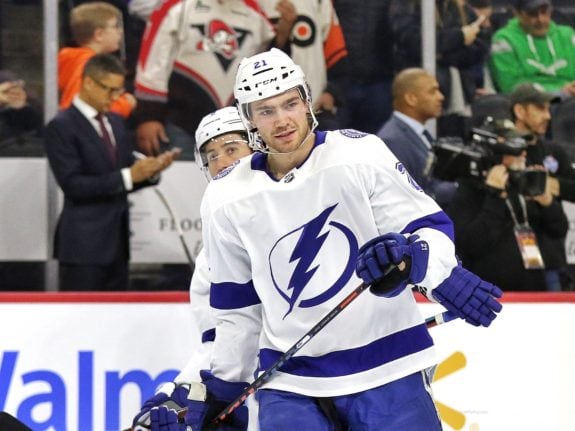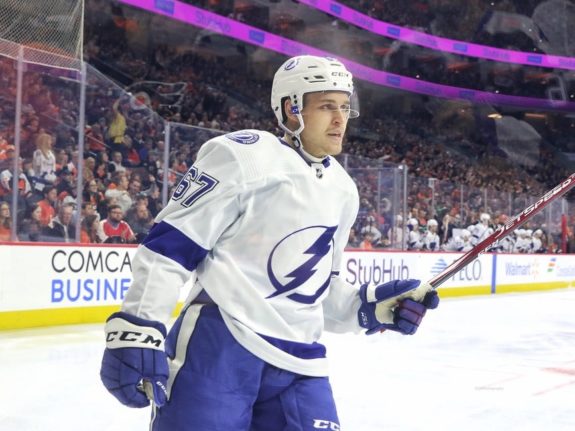
 Eugene Helfrick
The Hockey Writers
Eugene Helfrick
The Hockey Writers
52
Reads
0
Comments
Lightning: Looking At the 2020 Restricted Free Agent Class
For the Tampa Bay Lightning, the 2019-20 season was supposed to be one of redemption. After years of postseason meltdowns, Tampa Bay needed to win a Stanley Cup with their stacked roster that was considered one of the best in the NHL. As the playoffs approached, things were looking good, with everything in place to make a deep run once again.
However, with all the uncertainty surrounding the 2020 playoffs, Lightning fans find themselves looking towards the offseason far sooner than expected. While any offseason is busy, general manager Julien BriseBois will have his work cut out for him due to a swell of restricted free agents (RFAs) needing new contracts.
Related: Steve Yzerman’s Best Lightning Trades
See, over the last few seasons, the Lightning have come to rely on talented young players on entry-level contracts to fill in their nightly line-up. These players allowed them to put some NHL-caliber talent on the ice, at a fraction of the cost of a veteran alternative.

The only issue is that in the 2020 offseason, five of these RFAs are due for a raise. With this in mind, how can BriseBois and the Lightning navigate extending NHL starters like Anthony Cirelli, Mikhail Sergachev, Erik Cernak, Mitchell Stephens, and Carter Verhaeghe this offseason?
Lightning Short-Term Contract Extensions
Out of the five players due for a new contract, Verhaeghe and Stephens should be the most straightforward. Both of these players are borderline NHL’ers right now, providing good depth without being heavily relied upon.
With this in mind, either player could receive a small extension, say in the two-year, $1 to 1.5 million per year range. This would give them another season or two to prove that they are truly NHL ready without breaking the bank.

Plus, an extension like that would put these young, fringe players in a spot to be selected at the Seattle expansion draft, if necessary. By that point in their careers, they could be ready to take on a bigger role for Seattle that they simply wouldn’t receive in Tampa Bay, giving the budding franchise a skilled option to build around.
Lightning’s Potential Long-Term Extension
Of the RFAs due an extension in 2020, Cernak feels the most likely to sign a longer-term deal. As a defensive defenseman, he has taken over a consistent role in the Lightning’s top-four since 2018, and he is one of the team’s most important young players right now.
However, Cernak lacks those offensive numbers that typically garner an expensive bridge deal this early in his career. So, while he is a key part of the Lightning’s future, he shouldn’t break the bank either.

Given what we have seen in the past, it would make sense if Cernak signed a longer-term deal, say in the four to five-year range, costing roughly $3 to $4 million per year. This will keep him with the franchise until he is 27, where he will likely receive that massive six or seven deal depending on his development.
Bridge Deals That Could Help Lightning Now
If BriesBois is able to sign those three RFAs to reasonable deals, that will still leave him with Cirelli and Sergachev. Arguably, these two are the most important young players on the Lightning’s roster right now, and they will be looking for a raise that respects their talents.
While the Lightning would be thrilled to lock both players down to long-term, low-cost deals, that likely won’t be the case. These rising stars know that there’s a big payday in their future, so a short-term bridge deal may be in store this offseason.
Fortunately, after the great RFA crisis of 2019, we now have a better grasp of what a bridge deal should look like. For example, if an offensive dynamo like Brayden Point signed for $6.75 million per year or a top-end defenseman like Zach Werenski signed for $5 million, then you can use that as your top-end of the bridge deal market.

With this information in mind, I could see both Cirelli and Sergachev looking for two to three-year bridge deals that pay somewhere between $3.5 to $4.5 million per year. This would be relatively affordable given their production, while still setting them up for bigger paydays in a couple of years.
Can Lightning Fit the 2020 RFA Class?
Even in the best of circumstances, the Lightning’s 2020 RFA class is going to be difficult to maneuver through. With many players receiving big raises, cap space is going to be at a premium, forcing a trade of veteran talent.
However, with so much uncertainty around the NHL right now, this difficult situation may have become unmanageable. If the cap shrinks by any amount, the Lightning won’t have the room necessary to keep their core together.
Related: Lightning Deadline Deals Looking Better Even With Stoppage
If that happens, the team will have to be more active on the trade market than expected. While it is unlikely that a player like Cirelli or Sergachev gets moved, it may be necessary to make everything work for the 2020-21 season.
The post Lightning: Looking At the 2020 Restricted Free Agent Class appeared first on The Hockey Writers.
Popular Articles

















































 Blackhawks Chicago
Blackhawks Chicago Panthers Florida
Panthers Florida Penguins Pittsburgh
Penguins Pittsburgh Rangers New York
Rangers New York Avalanche Colorado
Avalanche Colorado Kings Los Angeles
Kings Los Angeles Maple Leafs Toronto
Maple Leafs Toronto Bruins Boston
Bruins Boston Capitals Washington
Capitals Washington Flames Calgary
Flames Calgary Oilers Edmonton
Oilers Edmonton Golden Knights Vegas
Golden Knights Vegas Senators Ottawa
Senators Ottawa Lightning Tampa Bay
Lightning Tampa Bay Flyers Philadelphia
Flyers Philadelphia Islanders New York
Islanders New York Sabres Buffalo
Sabres Buffalo Red Wings Detroit
Red Wings Detroit Devils New Jersey
Devils New Jersey Hurricanes Carolina
Hurricanes Carolina Blue Jackets Columbus
Blue Jackets Columbus Predators Nashville
Predators Nashville Wild Minnesota
Wild Minnesota Blues St. Louis
Blues St. Louis Stars Dallas
Stars Dallas Jets Winnipeg
Jets Winnipeg Mammoth Utah
Mammoth Utah Sharks San Jose
Sharks San Jose Canucks Vancouver
Canucks Vancouver Ducks Anaheim
Ducks Anaheim






